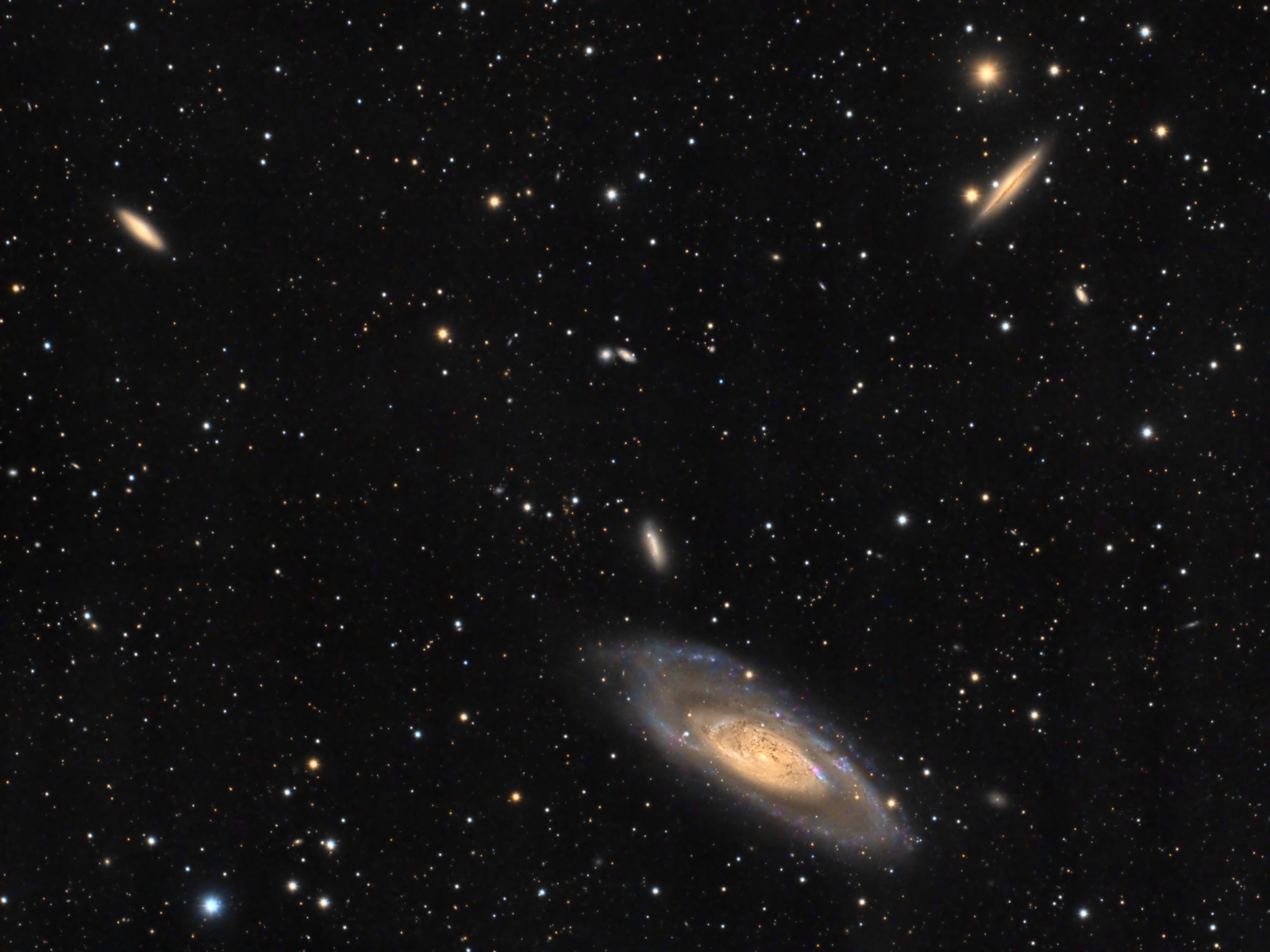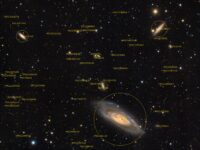Canes II Galaxy Group
 Click image for full size version
Click image for full size version
April 11, 2021
 M106 is the largest galaxy in this image, and the most prominent member of the Canes II galaxy group. It’s about 24 million light years away in the constellation Canes Vanatici (the Hunting Dogs), not far from the Big Dipper. M106 shows pink nebulae and bluish spiral arms. It is a Seyfert galaxy, meaning it has an active galactic nucleus. It’s thought that part of the galaxy is falling into a supermassive black hole near the centre.
M106 is the largest galaxy in this image, and the most prominent member of the Canes II galaxy group. It’s about 24 million light years away in the constellation Canes Vanatici (the Hunting Dogs), not far from the Big Dipper. M106 shows pink nebulae and bluish spiral arms. It is a Seyfert galaxy, meaning it has an active galactic nucleus. It’s thought that part of the galaxy is falling into a supermassive black hole near the centre.
There are many other galaxies in this image: look for fuzzy patches that appear different from the sharp, round stars. Some look like sharp streaks; others are round or oval; some even show structural details. Click on the annotated image at left to identify some of them. Notice, however, that many of them aren’t in the most common used galaxy catalogues! I also posted a separate image of NGC 4217, the brightest galaxy at upper right.
Tekkies:
Acquisition, focusing, guiding and control of Paramount MX mount with TheSkyX. Focus with Optec DirectSync motor and controller. Automation with CCDCommander. Equipment control with PrimaLuce Labs Eagle 3 Pro computer. All pre-processing and processing in PixInsight. Acquired from my SkyShed in Guelph. Average or better transparency and seeing. Data acquired March 4-21, 2021 under a mostly moonless sky.
Luminance: Sky-Watcher Esprit 150 f/7 refractor and QHY 16200-A camera with Optolong UV/IR and H-alpha filters
Chrominance: Takahashi FSQ-106 ED IV @ f/5 and QHY367C Pro one-shot colour camera with Optolong UV/IR filter
Luminance: 52x10m = 8hr40m
H-alpha: 21x10m = 3hr30m
Chrominance: 193x5m = 16hr05m
Total: 28hr15m
Data Reduction and Initial Processing
Preprocessing: The WeightedBatchPreProcessing script was used to create Luminance and H-alpha master frames (from the mono camera) and a RGB master frame (from the one-shot colour camera). DrizzleIntegration (1x) was applied to the registered RGB images. The RGB master was aligned to the Luminance master using StarAlignment
Gradient Removal: DBE was applied to Luminance and RGB masters using Subtraction.
Colour
Colour Balancing: Colour of the RGB master was balanced with ColorCalibration.
Linear Noise Reduction: MultiscaleLinearTransform was used to reduce noise in the background areas, using an internal mask to protect bright structures. Layer settings for threshold, strength and iterations were as follows: Layer 1: 5.0 0.85, 1 iteration; Layer 2: 3.5 0.75, 1 iteration, Layer 3: 2.0, 0.5, 1 iteration.
Stretching: HistogramTransformation was applied to make a pleasing, bright image, with background set to an intensity of approximately 0.10.
Luminance
Deconvolution: A star mask was made from the Luminance master to use as a Local Deringing Support Image. A copy of the image was stretched to use as a range mask. Deconvolution was applied (100 iterations, regularized Richardson-Lucy, external PSF made using the PSFImage script; Global dark deringing = 0.03).
Linear Noise Reduction: MultiscaleLinearTransform was used to reduce noise in the background areas of the Luminance-filtered image, using an internal mask to protect bright stars. Layer settings for threshold, strength and iterations: Layer 1: 5.0 0.85, 2 iteration; Layer 2: 3.0, 0.75, 1 iteration; Layer 3: 1.5, 0.25, 1 iteration.
Stretching: HistogramTransformation was applied to make a pleasing, bright image, with background set to an intensity of approximately 0.10.
H-alpha
Deconvolution: A star mask was made from the H-alpha master to use as a Local Deringing Support Image. A copy of the image was stretched to use as a range mask. Deconvolution was applied (50 iterations, regularized Richardson-Lucy, external PSF made using the PSFImage script; Global dark deringing = 0.02; Global light deringing 0.003).
Linear Noise Reduction: MultiscaleLinearTransform was used to reduce noise in the background areas of the H-alpha image. Layer settings for threshold, strength and iterations: Layer 1: 4.0 0.85, 1 iteration; Layer 2: 3.0, 0.75, 1 iteration; Layer 3: 2.0, 0.25, 1 iteration.
Stretching: HistogramTransformation was applied to the Ha to make a pleasing, bright image, with background set to an intensity of approximately 0.10.
Combining Luminance, Colour and H-Alpha Images
Creation of LRGB: The Luminance was applied to the RGB image using LRGBCombination with default settings.
Creation of HaLRGB: PixelMath was used to add Ha to the LRGB image, using the following expressions for the R, G and B channels:
R: max($T[0], 1.1*Ha)
G: $T[1]
B: iif($T[0]<Ha, $T[2] + 0.05*Ha, $T[2])
Additional Processing
Nonlinear Noise Reduction: TGVDenoise was used in L*a*b* mode to reduce noise with a mask used to target the background areas and protect the stars and nebula (max. 1,000 iterations and convergence selected for both lightness and chrominance).
Contrast Enhancement: HDRMultiscaleTransformation was applied to a clone of the image with scales of 6 and 4. The result was blended back 1:1 with the original using a mask to limit the blend to the core of the large galaxy. LocalHistogramEqualization was applied twice using the same mask, first with a scale of 40 (max contrast 1.5, strength 0.25, 1 iteration), followed by a scale of 150 (max contrast 1.5, strength 0.35, 1 iteration).
Sharpening: MultiscaleLinearTransform was used to sharpen Layers 2 and 3 with strengths of 0.1 and 0.08, respectively. A mask was used to protect background and stars and limit sharpening to bright galaxy features.
Final Steps: Background, galaxy and star brightness, contrast, and colour saturation were adjusted in several iterations using CurvesTransformation with masks as required. ICCProfileTransformation (sRGB IEC61966-2.1; Relative Colorimetric with black point compensation) was applied prior to saving in jpg format.






Excellent work!
Fantastic image Ron.
ABSOLUTELY GORGEOUS!!!